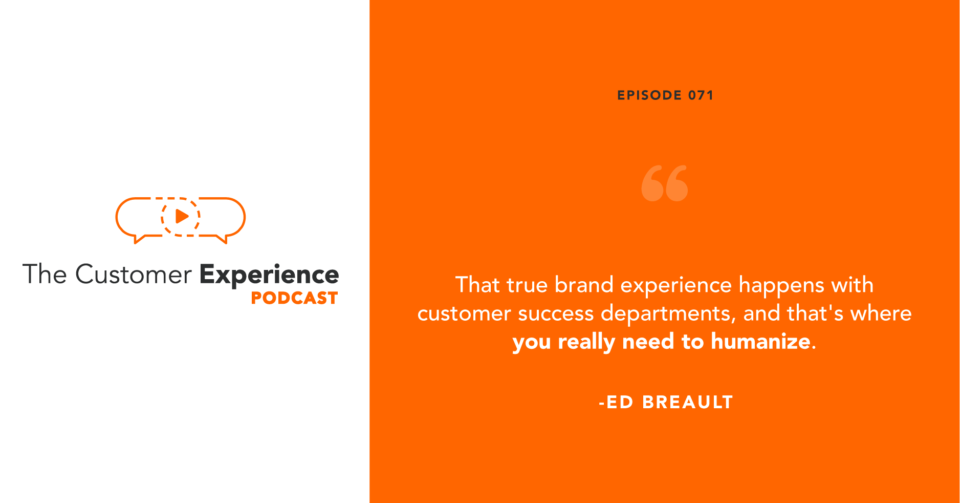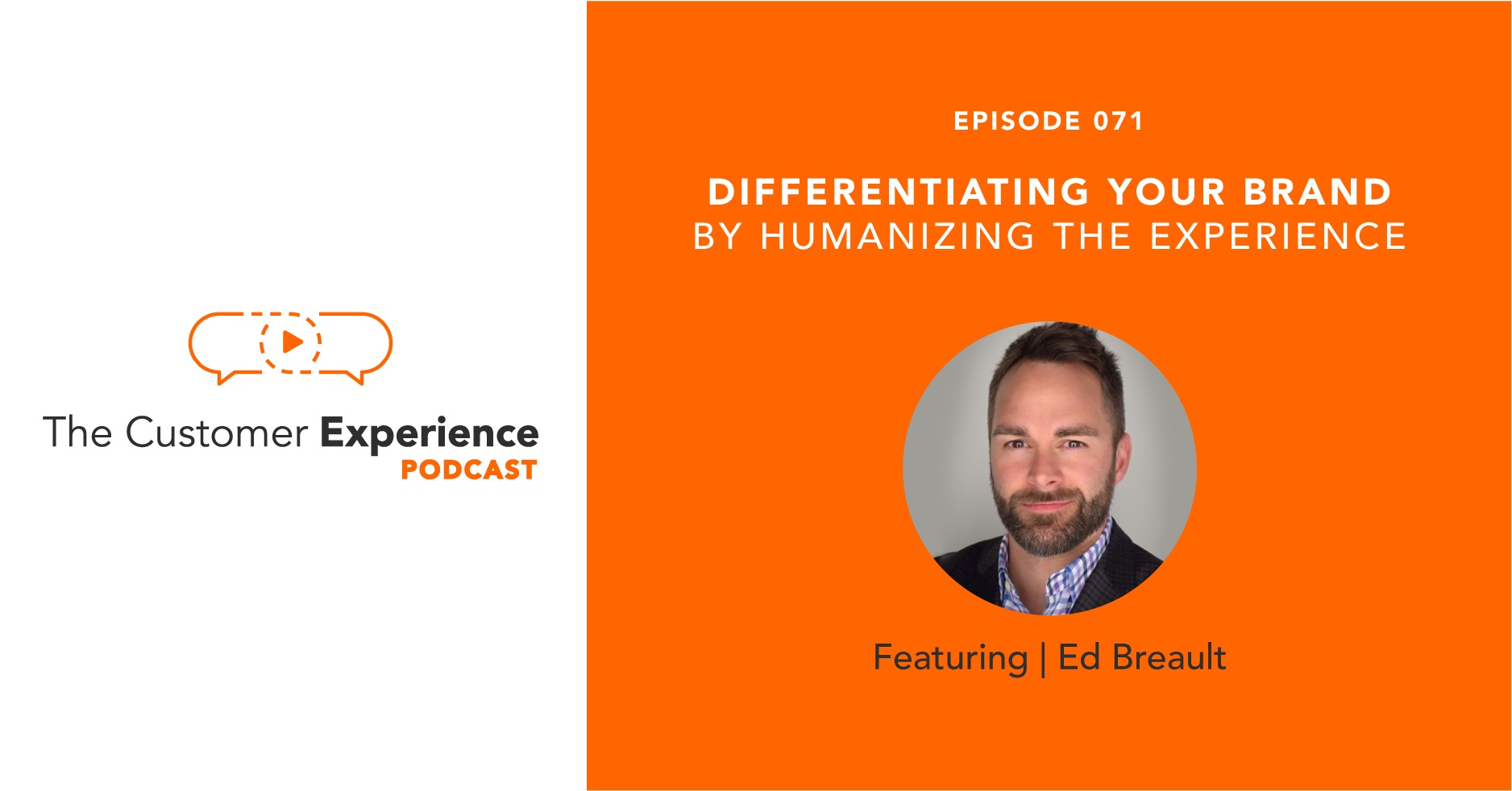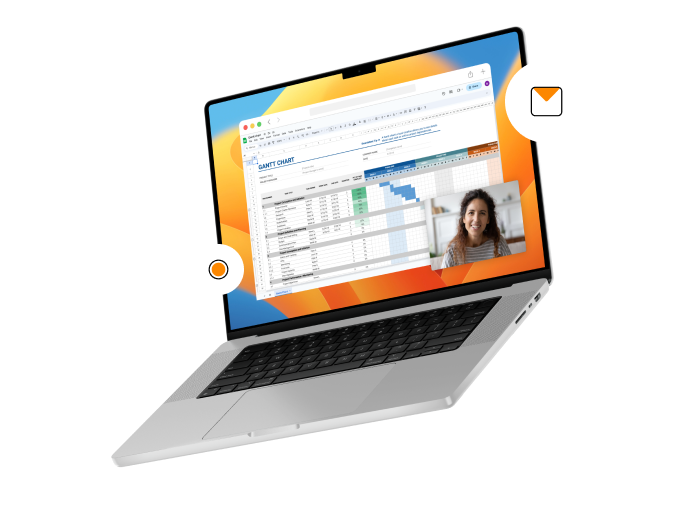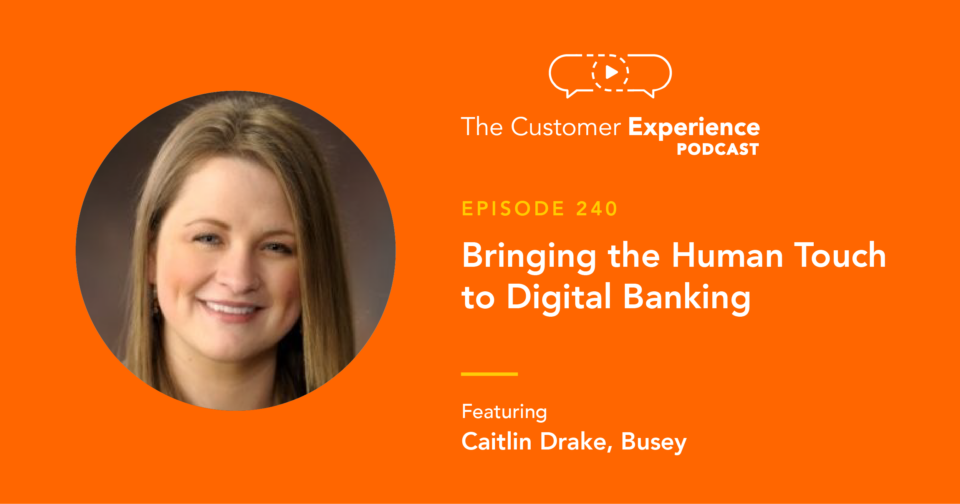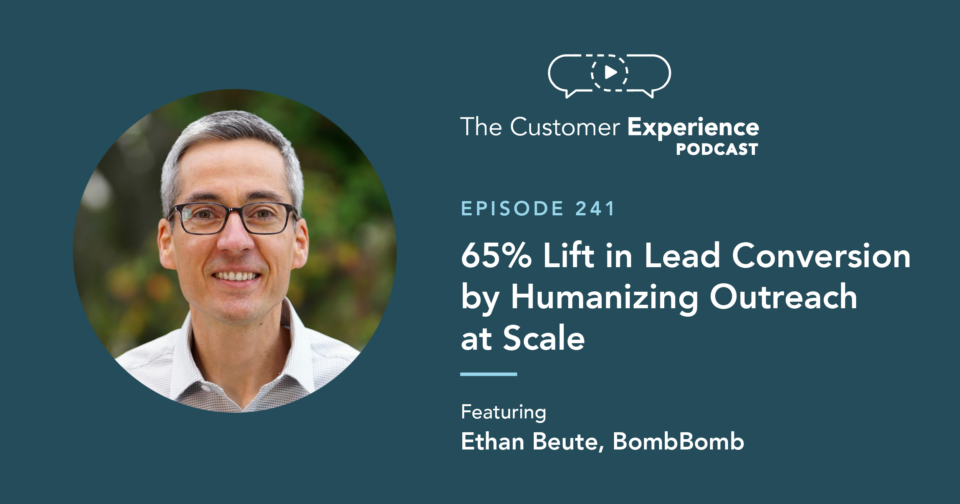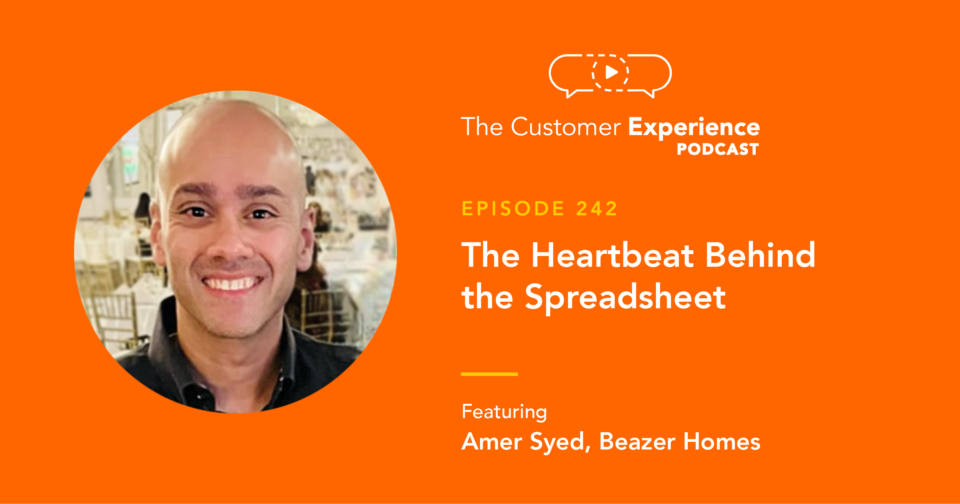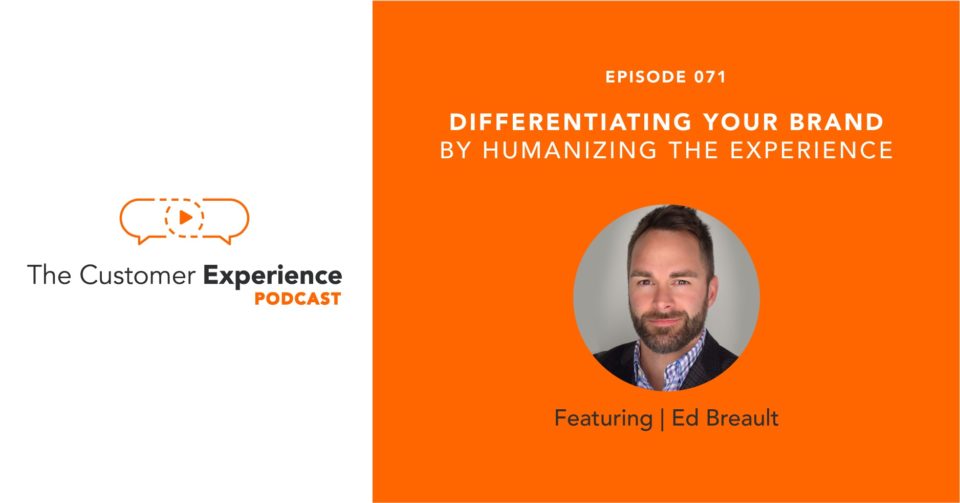
Listen to “71. Differentiating Your Brand by Humanizing The Experience w/ Ed Breault” on Spreaker.
Apple Podcasts | Google Podcasts | Stitcher | Spotify
Your brand is a promise. It’s a commitment that your customer experience will match the perceived value of your brand.
Therefore, it begins well before a customer ever becomes a customer. And it should encompass education, enrichment, human connection, and every other aspect and quality of working with you.
When a prospective customer really believes that your brand will stay true to the buying experience and that expectation is met, a premium brand is born. And consistent delivery makes a premium brand experience.
Our guest on this episode of The Customer Experience Podcast, Ed Breault, has spent the past dozen years in marketing, strategy, and pre-sales roles with Aprimo. The company is a digital asset management and marketing resource management platform serving 25% of Fortune 100 companies.
Aprimo is committed to providing a premium brand experience that supports critical, behind-the-scenes activities of their customers (think: Microsoft, CVS, and The Home Depot). As CMO, Ed is responsible for all aspects of global brand and growth – including brand experience, product marketing, demand gen, ABM, and more.
Our relationship began when he saw a copy of “Rehumanize Your Business” in the Pittsburgh airport and read it cover to cover. Its humanizing (or rehumanizing) message spoke to some of his key ideas and inititives for 2020.
Ed truly believes that humanizing the brand experience is what will set you apart. In fact, he even said that the Coronavirus pandemic was an opportunity to give his customers a metaphorical big hug.
In our conversation, we talk about …
• What defines the customer experience (from a brand perspective)
• How to achieve “extraordinary influence” within target accounts
• Why your brand and your buying experience need to match
• How “Rehumanize Your Business” served as a guidebook
• Why personal brands are the new corporate brands
Differentiating Your Brand by Humanizing The Experience
Hear the entire conversation with with Ed Breault on humanizing your brand experience right here:
Listen to “71. Differentiating Your Brand by Humanizing The Experience w/ Ed Breault” on Spreaker.
For a more traditional podcast experience, check out The Customer Experience Podcast in …
Once you click through, please take one minute to subscribe, rate, and review the podcast. It’s an easy way to support the show and help others find it.
Sign up for a monthly email with CX insights and highlights
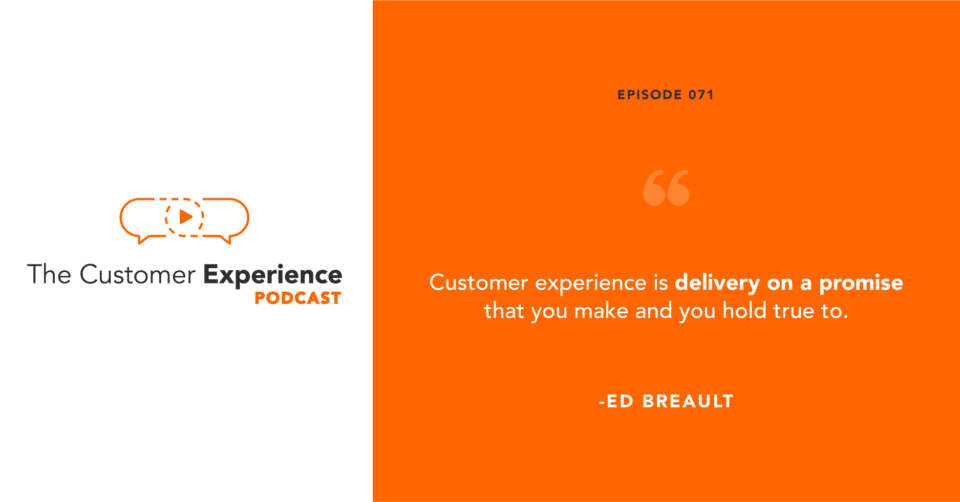
Full Transcript: Differentiating Your Brand by Humanizing The Experience
Ethan Beute:
Differentiating your brand by humanizing the experience. That’s the theme of today’s conversation. Our guest has spent the past dozen years in marketing, strategy and presales roles with Aprimo, a digital asset management and marketing resource management platform serving 25% of Fortune 100 companies. Their customers have household names like Microsoft, CVS, Kraft Heinz, Stanley Black & Decker, Bank of America and AT&T, to name a few. He currently serves as Aprimo’s Chief Marketing Officer and takes responsibility for all aspects of global brand and growth, including brand experience, product marketing, demand gen, ABM and more. Ed Breault, welcome to the Customer Experience Podcast.
Ed Breault:
Thanks for having me, Ethan.
Ethan Beute:
Yeah, I really appreciate you making the time. I know we’re in an interesting time. Before we get going in earnest, we’re recording this on Friday, March 20th of 2020. How has the Coronavirus affected you or your family or your customers or your work? Share any thoughts that you have right now. We were talking a little bit about triathlon and the mindset going in. I think that applies here as well. I’d love to open on any thoughts or experiences you’ve had lately.
Ed Breault:
Sure. Physically and emotionally, I think it’s brought us all closer together. I just posted a picture on LinkedIn with me and my three girls and my mini Australian shepherd all huddled up at the dining room table. They all have their laptops on. The consistency, the continuity of business and education, we need to keep pressing forward, but we’ve come together to do that now. That’s been fun. Then with customers, this is a great opportunity to give our customers a big hug because we’re all going through this together at the human level, which is what we’ll be talking about. The impacts aren’t just business centered. They’re being, what we’re going through, has a lot to do with our home lives and our personal lives. It’s not really a financial crisis. We look at some of the challenges we’ve had and have gone through before, this is a human situation. So I think it’s brought us all closer together.
Ethan Beute:
Yeah, really good perspective. That is one of the silver linings that I think became obvious as more people started sharing stories and photos like the one you just described is like we all get a lot more face time with our families. I know that you work not in the main office at Aprimo. I know you’re in Pittsburgh and the main office is in Chicago. But for me, I only work five minutes from my home, but I’m seeing my wife and son a lot more now than I was, say a month and a half, two months ago, which is a really nice silver lining. Then, on the other side of what you said there is, all of our customers and our future customers who we’re reaching out to are probably experiencing the same things.
Ethan Beute:
Let’s set aside any of the anxiety that the situation produces and just focus on the immediate situation. They’re seeing themselves, we’re experiencing ourselves a lot more as family members on a day-to day-basis, and so we can be our customers there and make a much stronger connection, I feel like, and we need to, to your point of we need to give them a hug. That’s really good language. Let’s get started in earnest here. Customer Experience is obviously the theme of the podcast, and so I always like to open with your thoughts or characteristics. When I say customer experience, what does that mean to you, Ed?
Ed Breault:
Yeah, customer experience for me is really that … when I deliver it, it’s really, I like to call it a brand promise. It’s really those things. The brand promise isn’t always explicit, but it’s that the truth in the delivery or service that you get from a product or brand. We can say things, we can write words down, we can have words up on a wall, but customer experiences delivery on a promise that you make and you hold true to, and hopefully that customer experience is really good. If it’s really good, then you create advocates of your brand or your product. That’s really the truth in transactions that we make today.
Ethan Beute:
Love it. It does obviously start with words, but it can’t just be words on a wall. Just go one step deeper there. As this promise that you’re making, the brand is making it, and of course the people are making it, do you have any mechanisms or approaches or things that you’ve done over the years to make sure that your people are bringing it to life and honoring the promise that you’re making in concept?
Ed Breault:
Absolutely. I think it’s this continuous from the point of them having a need for something and you delivering it, and then once it’s delivered, that value from what they’re looking for is eventually realized. Then, that’s, I think when the real experience starts because now that they’ve got that promise, realize that value is, can you stay in front of them adding value. Things that we do or how we think about it is that you always need to … it always has to be on, and it’s one of those things, it’s like take your iPhone as an example. If you don’t plug that thing in, what’s going to happen? That battery is going to drain. That’s the same thing with the customer experience. If you don’t continue to power it up and keep it plugged in, stay connected, then eventually the battery is going to turn red and it will shut off on you.
Ed Breault:
It’s one of these things that you need to have this continuous and interconnected from the nose to the tail of that which it is that you put in market and promise. So, making sure that you’ve got your energy, your focus on an empathy where they are in that journey with you, with your brand. Because, as we know, things continue to change and we need to understand where they are and then making sure that you’re valuable where they are, when they need you. Just really having that view approach and service level to always keeping that customer experience supercharged.
Ethan Beute:
Love it. Really simple analogy, but a really powerful one too. I liked that you added the timing element as well. Listeners have context. Obviously I introduced Aprimo generally, but I would love for you to talk about your company specifically. Who are your customers and what do you solve for them?
Ed Breault:
Absolutely. Aprimo is a digital asset management and work management software company. We are global in nature. As you mentioned, we definitely have a lot of enterprise brands. Digital asset management for customer experience, think about, one of our customers, The Home Depot as an example. Most folks know The Home Depot. Any piece of content that anybody has ever experienced to any touch point in the Home Depot experience, from the point of its origination to that touch point of experience, Aprimo powers all of those behind the scenes activities within the brand. The strategy, the planning, how they want to go to market, the budgeting, the workflow elements, how that content gets to market, making sure it’s aligned to strategy and that you get the team.
Ed Breault:
Now there’s work management aspect of working with the creative teams, your brand teams, if there’s regulation associated with things. All of your go-to-market teams stay aligned to get content out in all these experience channels like your eCommerce platform, like their amazing mobile device, where I learned how to redo all the plumbing in my kitchen. I re-install the sink with The Home Depots content, very rich educational content. Really that life cycle of content for an enterprise brand. They’re a really strong a brand that uses content to do great storytelling and education. Yeah, Aprimo is really the underpinnings of that in delivery of that content experience.
Ethan Beute:
Good job on your sink by the way. I assume that it’s all going well, and what a cool thing to be able to easily learn. Just one more layer here. I assume, these are my assumptions, so correct me where I’m wrong or affirm my assumptions. When you’re in the discovery phase, essentially the left side of a bow tie funnel prior to the commitment to do business with Aprimo, where are you starting in an organization? I assume that your sales and marketing folks are engaging probably multiple, multiple decision makers. This is deep into the brand and deep into your customer’s business, so there are probably multiple decision makers, but where’s that conversation starting on the buy side, and then once it gets turned over to a customer success, account management, however you define that for your organization, that who is your main point person within your … I just want to know from a customer, who are you connecting with on the side of Home Depot, for example, in the beginning and then as you renew for the fourth, fifth, six, eight year?
Ed Breault:
Yeah, absolutely. Yeah, my example was The Home Depot. Yeah, we have a financial services, insurance investments, retail banking, life sciences, pharma, so any enterprise that needs to deliver content experiences at scale. What you’ll find is that where we will land could be in different places. It could be a marketing driven initiative, it could be an eCommerce driven initiative. They could be going through a digital transformation and need strong work management capabilities, and they’re buying, to your point around lots of folks there, they’re buying with consensus. What we have to do is sell and/or meet them with consensus. There’s a lot of individuals in the buying group. So it’s a lot of research on, and we use a lot of predictive demand analytics. We will go and research these organizations, understand what roles are putting out the demand and the demand unit of the target accounts, or these accounts that are literally putting out the demand signals for Aprimo.
Ed Breault:
We will typically start in marketing, which is or an origination point. But what’s interesting is, marketing in some of these initiatives like customer experience, cross other functional areas of a business. So it’s no longer just marketing, but there could be actual customer experience teams that are driving these initiatives. They could be finance teams that are driving optimization from a cost standpoint. There could be a compelling event within a regulated industry, financial services or life science, where the need is. I want to say not everyone is a snowflake, but when you do the deep research and you’re looking at functional areas and/or roles, they tend to have different titles depending upon the industry and/or origination point. Deep research there. But what we then do is understand who’s active in the buying group and then who’s not active.
Ed Breault:
Then we look at who’s engaged with us and who’s not engaged, and what we then begin to do, I’ll call it the ultimate point of validation on, are we doing a good job to engage this brand? I call it extraordinary influence. Extraordinary influence within that organization to make sure that we’re creating, not just a one to many engagement, but one-to-one. Really getting down to the layer, the grain of the person, the individual, because oftentimes, they’ve got different motivators. I talked about cross-functionally, there’s different reasons for them to want to solve a problem. If we are talking about how we would solve that problem in a way that doesn’t land with them, we can often put them off and actually have it work against us. We really research heavily and we try to bring value and education and no empathize them and teach, tailor, take control. We use some of that methodology there. We want to be delivering value in a terminology and in a way that makes sense and is at that individual level.
Ethan Beute:
Yeah, I love it. It just tease up so much of where I want to go over the next 15, 20 minutes or so. Starting with, I guess, customer experience or brand experience, you used brand promise as the differentiator, as Aprimo’s differentiator. You own a good piece of the customer life cycle directly as chief marketing officer, including the SDR function. How do you view brand experience as a competitive differentiator?
Ed Breault:
It’s a really great point. I think that brand experience, as a differentiator, needs to match your, I’ll call it the value at which the product inner service level in your organization needs to be. At Aprimo specifically, we definitely consider ourselves and our … If you look at the Analysts, Forrester, Gartner out there with Forrester, we are in the leader’s wave for three actual waves. They consider us the, we’ll call it the top brand or the premium brand. So, what I’m challenged to do is say, so if we are the premium brand and our customers and our prospective customers appreciate sophistication or at best in breed solution, I need to have an experience now that is best in breed and the premium. If I could equate Aprimo to a top brand, I would say that I have to match that full experience.
Ed Breault:
What that means then is, and think about the buying process like the buying experience. If I’m going to buy a Tesla verse a lower end, economical automotive option, you’re going to get very different buying experiences. I have to make sure that that matches. Where we do that, the research, we bring the value, we educate, we want to enrich and deliver value even before they’re a customer, before there’s a transaction, we want to show them what it’s like to, once you become a customer, then it really starts, but show them early what it’s like. Tailoring their solutions, spending time, getting to know their business. We do that through various methods, but the idea is that it has to match. If there’s a mismatch, then you can’t use experience to differentiate. In some ways, the products that we do have can be left undifferentiated because some of the technological capabilities are … when you look at, there’s what? 7,000 MarTech tools out there.
Ethan Beute:
Yeah. That chart has gotten super crazy over the past two, three years in particular.
Ed Breault:
Yes. What we’ll have to do sometime is differentiate why a file on a shared server somewhere is different from a fully defined digital asset management for customer experience enterprise systems. Education really needs to happen. Also, leading in that buying experience, so people understand that we’re taking them down a path that makes sense for them.
Ethan Beute:
Yeah. I really like this idea that you have to …. If the challenge is to meet or exceed expectations, which I think it is, and it’s constantly ratcheting up and the Aprimo brand is already as a premium brand in multiple categories and you already have a high bar, and so I really appreciate your attention to that. I was privileged. Thank you again for the invitation to spend some time with you and your team, your chief revenue officer, so many of your team members at your annual kickoff earlier this year in Chicago. One of the ways that happened was you were at the Pittsburgh airport and you saw an orange covered book called Rehumanize Your Business. There it is. That was coauthored by me and my friend, and now your friend to Steve Pacinelli.
Ethan Beute:
When you first encountered that, because this is, I think, part of what you’re … as you’re trying to figure out how do I meet or exceed this premium experience, how do we make sure that I deliver on an individual level, I think there’s a gap that this may be closed, but you and I have never spoken explicitly about what was it when you saw it. What clicked for you around the concept of rehumanizing and video in particular?
Ed Breault:
Absolutely. First of all, the title was Rehumanize Your Business, and I was working, before I had seen this on this idea of humanizing Aprimo and what that meant, and I think what we found out, when I looked at data, I looked at first party win-loss data, I looked at customer surveys, I looked at third party win-loss data. The big differentiator for us and what we do had everything to do with building relationships and connecting with people, with the right individuals, finding the economic buyer, making sure that we were able to get them aligned around making a decision. So, we went down that journey. I saw the book and I picked it up. I was flying to San Francisco, actually a Napa Valley for a marketing event.
Ed Breault:
I read it cover to cover. When I landed, I picked up the phone and I called one of my colleagues. I said, I’ve got our blueprint. It really spoke to me. But then there’s all the things around what would it take to change? This really helped me understand the internal changes that we would have to go through, the cultural changes. We asked the question, are we more valuable in person? It was 100%, we were more valuable in person. Looked at, and again, I love data. I like the art and science. I like to consider myself like a whole brained marketer. The data told me, plus the science said to me, this sort of one to one seeing faces, communicating. We’ve been communicating face to face for 150,000 years. We’ve been literate for 5,000 years. Things like email, that’s texts that take the human elements of us out are 50 years old.
Ed Breault:
So, if we could get the science working in our favor and literally make it so much easier to communicate, that was a no brainer for me to start going down that road. Then it’s turning the cameras on. That was a whole thing too. I feel like this new technology over the last 50 years has really put so much distance. It’s brought us closer or faster to communicate, but it has created human distance that was totally gone now. If my job as a marketer is to create connections and communicate, and if my job as a revenue generating marketer is to create pipeline and win opportunities with my sales team, then I have to figure out what are those ways, what are those new methods of communication to make it more effective?
Ed Breault:
It was clearly rehumanizing our business, our customer experience, our brand experience. Then, even the early steps in customer experience and then even afterwards, whenever your product and like where the rubber meets the road. That true brand experience happens with customer success departments. That’s where you really need to humanize and where it really makes a difference too. Yeah, it’s really been a guidebook for us.
Ethan Beute:
Awesome. The one thing I really, really appreciated about your approach to it and some of our early conversation was again, going to this art and science piece. There are things that can’t be measured that are going on. You’re not going to see it in your funnel metrics when you communicate eye-to-eye, face-to-face, you speak very specifically to one person. You speak to their needs, you demonstrate, you truly demonstrate that you’ve done all the research and you can meet them where they are. Appreciating that some of that, it is going to eventually come out in the funnel metrics, but they’re not going to be right there in your face. There is a faith element at some level of like, I know this is the right thing and I just appreciate your vision around that.
Ethan Beute:
Something that came up when we were chatting while we were together in person was this idea, and I don’t know if these were your words or the way I heard your words, but it’s this idea that, for years I think, especially in what Seth Godin would call the television industrial complex where you just get enough money behind something, you run a whole bunch of ad campaigns on television and in print and whatever, the packaging, product packaging matches and you put a dollar in and you get $10 in revenue out and it was just this giant machine. In that way the marketers, the writers, the designers would essentially define what the brand is, that you could just write it down and put a whole bunch of money behind it and that was the brand, and people took the brand as you defined it. As we were talking, I think, around this humanization differentiation customer experience piece that your people, your team members define the brand interaction by interaction. Did that trigger anything for you? Again, your team members define the brand, not your copywriters.
Ed Breault:
Exactly. Yeah. I’ve got a couple of mantras for 2020. One is that the new personal brand is new company brand and the customer is the best marketer. With those mantras, the idea is that, at the interface point, and what somebody actually gets is they get Ashley in customer success, they get Joris in our customer experience team, they get Eli as on the front end, SDR, BDR. When people think about the customer experience that Aprimo delivers, it’s not what the copywriters write. It’s not the blog or the tone or all that stuff that’s in the brand book. It’s really that person from the brand, it’s how they help. It’s their approach. It’s their empathy. It’s their time, their energy, their knowledge, their experience they bring to the table.
Ed Breault:
Because if you think about it, the product is the same regardless of who gets it. The difference now is that interface between the product and the customer, which is the person, and what we found is that, the individuals who really think person first and we know people buy from people, the buy is really transactions as well. That transaction with the service level there in the middle is up to the individual. So, empowering them to be the brand is really what I want to do. I want to create a brand experience platform for every individual of my company to want to get up onto and bring their whole self to work every day and their own unique spin on it, but then a level of value that you can only get if they bring their whole self to work every day.
Ed Breault:
So, giving them permission to be themselves and deliver as much value as possible. I really think that humanizing the brand experience has to be a process of enablement and give permission and go through the process several times, so they just feel comfortable getting all of this technological and business barrier out of the way. We have to undo so many things that we’ve put up between us and our customers. That’s really this the process that we’re going through right now.
Ethan Beute:
Both of those mantras are just so powerful. I think the way you talked about it is, word sounds soft, but it’s just beautiful, this trust in people, and the acknowledgement that this is true. What you said is absolutely true, but it’s this fundamental shift still from a practical standpoint, from the way we think we’re supposed to do it. Plug people exclusively into the process and functionally treat them interchangeably. That’s the most hardcore process orientation. You cannot ignore the fact that these people do deliver the experience, and so this trust and confidence and permission is just such a great employee experience. Then of course, that’s the necessary precursor to a great customer experience. I think you were right at the edge of, I think what you term life flow. Could you speak to that a little bit? I feel like you were right there on the doorstep and/or you were talking about it without using that term, but that’s something that stuck with me again from our time together earlier this year.
Ed Breault:
Yeah. Life flow, it is understanding … we talk about workflow and we talk about work and the process of our day-to-day, but life flow really it embraces and it gets back to that giving permission. It’s this concept or term, is that as knowledge workers. A lot of us are knowledge workers now and some of the way we do work is going back to eras of commercial and in business like factories. When you think about the different eras of business, we are in a new era of knowledge work. You can’t really clock in, clock out like a factory worker would. You can’t turn on the conveyor belts of productivity and production anymore. Your brain is your job. When your brain is your job, that thing can work for you any time, and that’s good. That’s bad.
Ed Breault:
I do my best work, we were talking about triathlon in cycling, I do my best work when I’m running or biking or swimming, and I’ll bring data with me and I’ll solve some of my problems outside the virtual office or the brick and mortar office. Life flow really gets down to … it’s a trust thing. It gets down to creating a culture in the organization and with your customer experience that work can happen any time. Then creating an environment with technology, with very well-defined methods of communication and interaction. So, it’s not just ad hoc, we do work whenever, but it’s actually really well-defined, structured boundaries on the agreement to do work. But it’s not, we will work during these hours, and when you’re here, you’re working, and if I see you, you’re working.
Ed Breault:
It’s, we now look at work output verse how it gets done and embrace the things that in 2020 are a reality for us, virtual work and working with teams that are from a third party. The idea that knowledge work happens and you can’t physically see it happen, but then also, you’ve got to turn that off too. It’s the, now I’m turning off, now I’m the father, now I’m the mother, now I’m the son, now I’m the husband, et cetera. It’s an agreement with yourself that says you know your boundaries, you know when you need to turn it off, you know when you need to recharge and then come back to give your best work. Sometimes, some people’s best work is … knowledge workers again, need to go somewhere to get inspired, go on a hike, go in the woods, go stare at a body of water, go read a book. Know that that’s work too.
Ed Breault:
So, it’s really trust in getting work done, but then creating an environment culture around the individual in the organization and agreements with customers that that’s the new method.
Ethan Beute:
Yeah, I really liked that. I think again, there’s a strong permission element in there and a high level of self-awareness. It requires a new skill set to manage this really well. It’s interesting. My career spanned a little bit of both. I may have been a knowledge worker the whole time, but specific output has been part of my roles in the past before. It’s like I’ve been in this shift, and it’s been really interesting. Self-awareness has been really critical. One quick followup question there. Do you set out …? This is just for my own benefit and whoever else is in my own experience. I’m not a triathlete, but I do run a lot and hike a lot and walk around in the woods. Do you specifically, when you set out on a ride or set out on a swim, do you specifically set out to solve a particular problem? Because sometimes I’m not disciplined about it. I’ve done a little bit of both, but haven’t gotten really good at trying to solve a specific problem on a specific run. Are you in high level of intention there?
Ed Breault:
Absolutely. Absolutely. Like you said, self-aware. I know that I do my best work when I’m pretty sure that there’s some physical attributes to this. My brain works better whenever I’m … I get my heart rate up to above 140 beats per minute because. What’s happening, scientifically, we’re flushing waste products out of our brain and the blood, our heart’s doing its work. So, I will bring problems with me. I will say, okay, I’m getting up right now and I’m going to go hit the weather permitting, I’ll go hit the trail or I’ll hit the treadmill. Okay, I need to solve this problem on a run or solve this problem in the pool or solve this problem on the bike. I will sit there and move through the problem solving or data analysis in my head. I find that it’s this being in motion for me, this forward movement also allows me to get a very focal … put a very narrow view on something that I need to focus on.
Ed Breault:
You cannot distract me. I can’t get a phone call. I can’t respond to email. I can’t multitask. When I’m on my bike and my hands are down in the triathlon bars, I’m not going anywhere. I’m not multitasking. I got one thing on my brain and I use the full power of my brain on specific things. But then, here’s the new problem. It’s okay, I just had some brilliant ideas, how do I capture these notes? I will literally be, let’s say 10 miles into a bike ride, get off, hit the pause button on my workout watch, and I will sit there and either voice to text, emails to myself or jot some notes down. We use Microsoft Teams and Slack channels and things like that. There are Saturdays where I’m out on a long ride or run and I will drop notes to my team on some ideas, some breakthrough ideas, some thought starters for some podcast that we want to do or other content that we want to produce or the words we want to use.
Ed Breault:
Again, marketing, it’s like we get creative with linguistics of business, and I find that I can find the right words to use to describe complex challenges or problems or products whenever that sort of life flow opportunity comes to me on a workout.
Ethan Beute:
Really good. I love that you identified that problem because I know that I’ve lost, I don’t know if they were million dollar ideas, but I know that I’ve lost so many ideas for not having that discipline to stop it and capture it. Awesome, I’m really glad I asked that follow up. This has been awesome, but we’re up against it. I want to honor our number one core value of relationships here by giving you the chance to thank someone who has had a positive impact on your life or your career.
Ed Breault:
Absolutely. I would say somebody who, and I’ve known this individual for 15 years, he’s challenged me through various roles at Aprimo the whole time. He’s my current CEO, John Stammen. He’s somebody who, no matter where I was in my career, looked at me and knew I was able to be challenged and pushed. I think I let him know early on that I grow through struggle, and so he has always trusted me, giving me just enough space to grow into. Then whenever he has seen me grow into that space, giving me more and more and more. Yeah, I would not be doing what I’m doing and as passionate about what I’m doing in my career if I didn’t have that constant coaching challenge and then friend as part of that.
Ethan Beute:
That’s wonderful. It sounds like you’re doing that with some of your team members as well with giving them space and recognizing them for who they are and letting them grow within that. How about, name a company that you really like or respect for the way that they deliver for you as a customer?
Ed Breault:
Sure. Other than BombBomb, of course.
Ethan Beute:
Yeah. Thank you for that. It’s been a really cool partnership, by the way. Thank you so much for sharing the vision and allowing us to help you realize some of the ideas that you were already developing yourself. I’ll let you give another one besides BombBomb.
Ed Breault:
Yeah, I know. Obviously as CMO, there’s a lot of technology in my tech stack that makes a difference. Another piece of tech that we use, where there’s the technology, but then there’s the engagement with us is a company called 6sense. They do predictive demand analytics. You know that you’ve got a great relationship when you have a personal relationship with at least 20 people at that company. There are at least 20 people at that company that I have met and we’ve maintained a relationship from the CEO, to the CMO, Latane Conant. I actually just had a coffee talk with her this morning before this. Then other individuals at that company, from their customer experience team, their field marketing team, their demand team, where we have a great relationship and they are sharing some of their innovations with me, maybe even before they get to market. I just want to say that I feel like I’m part of their journey as well. So, big shout out to them, core piece of my revenue and customer experience tech stack.
Ethan Beute:
That’s great. It sounds like you as a customer are one of their marketers as is your mantra.
Ed Breault:
Yeah. It is. I’m not making this stuff up. It’s real, and I often walk the talk too and try to emulate that back with my business. But yeah, I couldn’t do what I do without great partners like BombBomb, like 6sense and others, the long tail of other tech companies who go above and beyond the transaction.
Ethan Beute:
I love it. I really appreciate your perspective. Obviously, I love your balance of art and science. I love your view of a whole brain, and obviously mind body as well that it’s all right there. I just really appreciate who you are, Ed. I appreciate you spending time with me. If folks enjoyed this, and I assume that if they’re listening at this moment, they enjoyed it because here we all are at the end of the conversation, how could folks follow up with you, with Aprimo or anywhere else that you’d like to maybe send them?
Ed Breault:
Sure. I would say LinkedIn is my number one platform. Ed Breault on LinkedIn. Then, Aprimo is aprimo.com. We’re always pumping out great content on customer experience but more with content centricity to it, digital transformation, work management. We’re now talking about the future of work. I think we’re living in the future of work. I think the future of work came faster than we all thought with working virtually, remotely, regardless of whatever the human situation, work continuity must go on. Yeah, any of those places and I’m always up for a great discussion.
Ethan Beute:
Super. I’ll link that up at bombbomb.com/podcast. Thank you again, Ed, and thank you for listening to the Customer Experience podcast.
Ed Breault:
Thank you, Ethan.
Ethan Beute:
Awesome. Right.
Video Highlights: Humanizing the Brand Experience
Check out the top five video highlights from the discussion with Ed below…
1. Brand Experience and Customer Experience
2. “Extraordinary Influence” and One-To-One Communication
3. Why the Brand and Buying Experience Must Match
4. “Rehumanize Your Business” with Human-to-Human Videos
5. Personal Brands As The New Company Brand
Other CX Conversations You’ll Enjoy:
- “Take Care of Your Brand and It Will Take Care of You” with Kurt Bartolich (Founder, GUTS Branding)
- “Brand Legacy Is A Human Thing (Not A Corporate Thing)” with Kristy Krueger (VP of Marketing, Revel)
- “Connecting with Customers by Exploring a Shared Belief” with Steve Pacinelli (CMO, BombBomb)
Please Subscribe to and Rate The Customer Experience Podcast:
